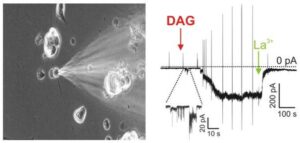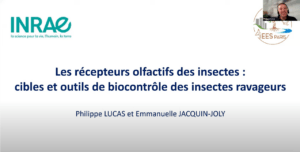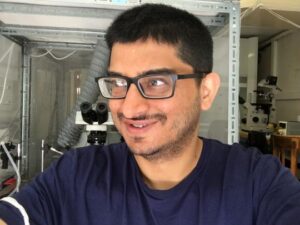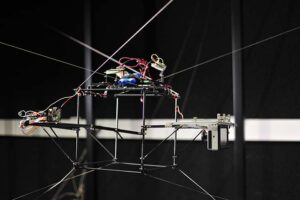Nos recherches expérimentales complétées par des modélisations théoriques visent à comprendre les processus de reconnaissance du signal olfactif et sa traduction en réponse comportementale adaptée à l’environnement et selon l’état physiologique de l’individu. Elles concernent les processus du codage sensoriel depuis la transduction du signal odorant par les neurones récepteurs olfactifs de l’antenne jusqu’à son intégration dans le système nerveux central par le réseau de neurones du lobe antennaire et sa traduction en réponse locomotrice orientée.
Nous étudions comment l’insecte répond à un signal spécifique dans un environnement sensoriel complexe (interactions phéromones / odeurs de plantes) et les mécanismes de modulation de cette réponse par des signaux internes, en particulier sous l’influence d’hormones stéroïdes impliquées dans le développement.

Nous utilisons des approches :
- anatomiques (neuroanatomie quantitative, colorations intracellulaires),
- moléculaires (clonage, hybridation in situ, interférence d’ARN, expression hétérologue),
- électrophysiologiques (électroantennographie (EAG), enregistrement monosensillaire (SSR), enregistrement juxtacellulaire, patch clamp in vivo et in vitro),
- d’imagerie (imagerie calcique),
- comportementales (divers olfactomètres, compensateurs de locomotion et tunnels de vol sont utilisés pour enregistrer et analyser la réponse comportementale de l’insecte à des signaux odorant ; trajectométrie, tests d’apprentissage),
- biochimiques (immuno-dosage de stéroïdes),
- physico-chimiques (chromatographie en phase gazeuse couplée au comportement)
- et modélisatrices (analyses statistiques, simulations informatiques, robotique)
Ces diverses approches servent à étudier le fonctionnement des neurones et des réseaux de neurones et par ailleurs, les modifications de ce fonctionnement (e.g. en lien avec le changement global, la présence de molécules d’origine anthropique).
Modèles d’études
Nous utilisons le modèle de la communication phéromonale chez les lépidoptères, sur la noctuelle Agrotis ipsilon, en raison de sa sensibilité, sa spécificité et des comportements stéréotypés qu’elle engendre. Nous utilisons la drosophile pour les approches mécanistiques en raison des outils de génétique qu’elle offre.
Notre savoir-faire sur nos modèles d’études nous permet de travailler sur d’autres arthropodes pour leur pertinence écologique ou agronomique (charançon rouge du palmier, guêpe de l’amandier, crevette, etc…).
-
Objectifs
- Etudier et modéliser les aspects qualitatifs, intensitifs et temporels du codage de l’information olfactive au niveau du système nerveux périphérique et central.
- Disséquer et modéliser les voies de signalisation impliquées dans la transduction olfactive.
- Etudier les mécanismes sous-jacents de la plasticité liée à l’état physiologique.
- Analyser les interactions entre signal olfactif et paysage odorant. Nous étudions en particulier comment les odeurs végétales modulent les réponses à la phéromone, de la détection à la réponse comportementale.
- Mieux évaluer le rôle de l’environnement olfactif dans la modulation de l’attraction à distance dans une perspective agronomique.

P. Lucas©UMR7618
Actualités de l'équipe
Journées du réseaux ADALEP 2023
Les 24 et 25 octobre, le département Ecosens a accueilli...
Lire la suiteiEES les femmes !
A l'occasion de la journée internationale des droits des femmes...
Lire la suiteWebinaire du colloque Ecophyto Recherche & innovation
Philippe Lucas et Emmanuelle Jacquin-Joly, du département ECOSENS, ont répondu...
Lire la suiteThe Conversation – La « pollution sensorielle », qu’est-ce que c’est et comment la combattre ?
L’espèce humaine est un voisin bruyant qui laisse la lumière...
Lire la suitePortrait – Abhishek Chatterjee, explorateur des sens des insectes
Recruté sur concours INRAE en 2020, Abhishek Chatterjee intègre l’Institut...
Lire la suiteLa biologie de la conservation doit-elle prendre en compte les paysages odorants ?
Les modifications anthropiques des paysages odorants affectent-elles le fonctionnement des...
Lire la suiteProjets iEES Paris retenus dans le cadre du Programme prioritaire de recherche (PPR) “Cultiver et Protéger Autrement”
2 projets ont été retenus dans le cadre du Programme...
Lire la suiteUn robot pour suivre et filmer le vol des insectes
Des scientifiques du CNRS, de l’université de Lorraine et d’Inrae(1)...
Lire la suitePublications de l'équipe
Ne concerne que les publications de 2017 à aujourd’hui. Pour voir toutes les publications dirigez-vous vers la page Publications.
| Référence | Liens | Journal |
|---|---|---|
| Force E.~, Couzi P.*, Dacher M.*, Debernard S.* (2023), Diet Impacts the Reproductive System’s Maturation in the Male Moth Agrotis ipsilon (Noctuidae, Lepidoptera), J Insect Physiol, 148:104532. | https://doi.org/10.1016/j.jinsphys.2023.104532 🔗 HAL | J Insect Physiol |
| Li Z.~, Capoduro R.^, Zhang S.~, Sun D., Lucas P.*, Dabir-Moghaddam D.^, François M.C.*, Liu Y., Wang G., Jacquin-Joly E.*, Montagné N.*, Meslin M.*(2023) A tale of two copies: evolutionary trajectories of moth pheromone receptors. Proc Natl Acad Sci USA 120 (20) | https://doi.org/10.1073/pnas.2221166120 🔗 HAL | Proceedings of the National Academy of Sciences of the United States of America |
| Aguilar P., Bourgeois T., Maria A.*, Couzi P.*, Demondion E., Bozzolan F.*, Gassias E., Force E.~, Debernard S.* (2023), Methoprene-tolerant and Krüppel homolog 1 are actors of juvenile hormone-signaling controlling the development of male sexual behavior in the moth Agrotis ipsilon, Horm Behav, 150:105330 | https://doi.org/10.1016/j.yhbeh.2023.105330 🔗 HAL | Horm Behav |
| Zheng Y.~, Cabassa-Hourton C.*, Planchais S.*, Crilat E.*, Clément G., Dacher M.*, Durand N.~, Bordenave-Jacquemin M.*, Guivarc’h A.*, Dourmap C.~, Carol P.*, Lebreton S.*, Savouré A.* (2022). Pyrroline-5-carboxylate dehydrogenase is an essential enzyme for proline dehydrogenase function during dark-induced senescence in Arabidopsis thaliana. Plant Cell and Environment. Online ahead of print. | 10.1111/pce.14529 🔗 HAL | Plant Cell and Environment |
| Vandroux P.°, Li Z.~, Capoduro R.^, François M-C.*, Renou M.*, Montagné N.*, Jacquin-Joly E.* (2022) Activation of pheromone-sensitive olfactory neurons by plant volatiles in the moth Agrotis ipsilon does not occur at the level of the pheromone receptor protein. Front. Ecol. Evol., 10:1035252 | 10.3389/fevo.2022.1035252 | Frontiers in Ecology and Evolution |
| Renou M.* (2022) Is the evolution of insect odorscapes under anthropic pressures a risk for herbivorous insect invasions? Current Opinion in Insect Science. 52: 100926 | 10.1016/j.cois.2022.100926 | Current Opinion in Insect Science |
| De J, Chatterjee A*. (2021) Perception of Daily Time: Insights from the Fruit Flies. Insects. 2021 Dec 21;13(1):3 | 10.3390/insects13010003 🔗 HAL | insects |
| Lucas P.*, Anton, S. (2021) Editorial: Invertebrate neurobiology: Sensory Systems, Information Integration, Locomotor- and Behavioral output. Front. Physiol. 12:807521 | 10.3389/fphys.2021.807521 🔗 HAL | Frontiers Physiology |
| Frat L~, Chertemps T*, Pesce E, Bozzolan F*, Dacher M*, Planelló R, Herrero O, Llorente L, Moers D, Siaussat D*. Single and mixed exposure to cadmium and mercury in Drosophila melanogaster: Molecular responses and impact on post-embryonic development. Ecotoxicol Environ Saf. 2021 May 27;220:112377. | 10.1016/j.ecoenv.2021.112377 🔗 HAL | ECOTOXICOLOGY AND ENVIRONMENTAL SAFETY |
| Conchou, L^.; Lucas, P*.; Deisig, N*.; Demondion, E.*; Renou, M*. Effects of Multi-Component Backgrounds of Volatile Plant Compounds on Moth Pheromone Perception. Insects 2021, 12, 409. | 10.3390/insects12050409 🔗 HAL | Insects |
| Haouzi, M., Gévar, J*., Khalil, A., & Darrouzet, E. (2021). Nest structures display specific hydrocarbon profiles: insights into the chemical ecology of the invasive yellow-legged hornet Vespa velutina nigrithorax. Chemoecology, 1-12. | 10.1007/s00049-021-00343-7 🔗 HAL | Chemoecology |
| Gassias E, Maria A*, Couzi P*, Demondion E*, Durand N, Bozzolan F*, Aguilar P, Debernard S*. (2021) Involvement of Methoprene-tolerant and Krüppel homolog 1 in juvenile hormone-signaling regulating the maturation of male accessory glands in the moth Agrotis ipsilon. Insect Biochem Mol Biol. 2021 May;132:103566. | 10.1016/j.ibmb.2021.103566 | INSECT BIOCHEMISTRY AND MOLECULAR BIOLOGY |
| RENOU, Michel* ; SORDELLO, Romain ; REYJOL, Yorick, La biologie de la conservation doit-elle prendre en compte les paysages odorants ?, Science Eaux & Territoires | 10.14758/SET-REVUE.2021.HS.03 | Science Eaux & Territoires |
| Renou, M. Mesurer le comportement olfactif des insectes.Insectes, 199:11-15 | Insectes | |
| Murmu M.S.^, Hanoune J.°, Choi A.°, Bureau V.°, Renou M.*, Dacher M.*, Deisig N.*, Modulatory effects of pheromone on olfactory learning and memory in moths. Journal of Insect Physiology, J Insect Physiol 127, 104159. | 10.1016/j.jinsphys.2020.104159 🔗 HAL | Journal of Insect Physiology |
| Aviles A.~, Cordeiro A.°, Maria A.*, Bozzolan F.*, Boulogne I.^, Dacher M.*, Goutte A.°, Alliot F., Maibeche M.*, Massot M.*, Siaussat D.* (2020) Effects of DEHP on ecdysteroid pathway, sexual behaviour and offspring of the moth Spodoptera littoralis. Hormones Behav, 125: 104808. | 10.1016/j.yhbeh.2020.104808 🔗 HAL | Hormone and Behaviour |
| Pannequin R., Jouaiti M., Boutayeb M., Lucas P.*, Martinez D. (2020) Lab-on-cables: Automatic tracking of free-flying insects. Science Robotics 5(43):eabb2890. | 10.1126/scirobotics.abb2890 🔗 HAL | Science Robotics |
| Pawson S. M., Kerr J. L., O’Connor B., Lucas P.*, Martinez D., Allison J. D., Strand T. M. (2020) Light weight portable electroantennography device as a future tool for applied chemical ecology. J. Chem. Ecol. 46 :557-566. | 10.1007/s10886-020-01190-6 🔗 HAL | Journal of Chemical Ecology |
| Renou M.*, Anton S. (2020) Insect olfaction in a complex and changing world. Current Opinion in Insect Science, 42:xx-yy. | 10.1016/j.cois.2020.04.004 🔗 HAL | Current Opinion in Insect Science |
| Hoffmann A.°, Bourgeois T.*, Munoz A.°, Anton S., Gevar J.*, Dacher M.*, Renou M.* (2020) A plant volatile alters the perception of sex pheromone blend ratios in a moth. J Comp Physiol A, 206, 553-570. | 10.1007/s00359-020-01420-y 🔗 HAL | JOURNAL OF COMPARATIVE PHYSIOLOGY A- NEUROETHOLOGY SENSORY NEURAL AND BEHAVIORAL PHYSIOLOGY |
| Fraichard S., Legendre A., Lucas P., Chauvel I., Faure P., Artur Y., Neiers F., Briand L., Ferveur J.-F., Heydel J.-M. (2020) Modulation of sex pheromone discrimination by the UDP-glycosyltransferase Ugt36E1 in Drosophila melanogaster. Genes 11(3). | 10.3390/genes11030237 🔗 HAL | Genes |
| Hostachy C.^°, Couzi P.*, Portemer G.°, Hanafi M.°, Murmu M.^, Deisig N.*, Dacher M.* (2019)Exposure to conspecific and heterospecific sex-pheromones modulates gustatory habituation in the moth Agrotis ipsilon. Frontiers in Physiology, 10: 1518. | 10.3389/fphys.2019.01518 🔗 HAL | Frontiers in Physiology |
| Hostachy C.°^, Couzi P.*, Hanafi-Portier M.°, Portemer G.°, Halleguen A.°, Murmu M.^, Deisig N.*, Dacher M.*, 2019. Responsiveness to sugar solutions in the moth Agrotis ipsilon: parameters affecting proboscis extension. Frontiers in Physiology, 10: 1423. | 10.3389/fphys.2019.01423 🔗 HAL | Frontiers in Physiology |
| Renou, M*, Les insectes ingénieurs. 5. Odeurs et biomimétisme. Insectes,195: 17-21. | Insectes | |
| Conchou L. ^, Lucas P. *, Meslin C. *, Proffit M., Staudt M., Renou M. * (2019) Insect Odorscapes: From Plant Volatiles to Natural Olfactory Scenes.Front. Physiol. 10:972. | 10.3389/fphys.2019.00972 🔗 HAL | Frontiers in Physiology |
| Levakova M., Kostal L., Monsempès C. *, Lucas P. *, Kobayashi R. (2019) Adaptive integrate-and-fire model reproduces the dynamics of olfactory receptor neuron responses in moth. J. R. Soc. Interface 16:20190246. | 10.1098/rsif.2019.0246 🔗 HAL | Journal of The Royal Society Interface |
| Maria A.*, Malbert-Colas A~. Braman V.^, Dacher M.*, Chertemps T.*, Maïbèche M.*, Blais C.*, Siaussat D.* 2019 Effects of Bisphenol A on post-embryonic development of the cotton pest, Spodoptera littoralis. Chemosphere 235, 616-625. | 10.1016/j.chemosphere.2019.06.073 🔗 HAL | Chemosphere |
| Chapuy C.°~, Ribbens L., Renou M.*, Dacher M.*, Armengaud C. (2019) Thymol affects congruency between olfactory and gustatory stimuli in bees. Sci Rep, 9: 7752. | 10.1038/s41598-019-43614-8 🔗 HAL | Scientific Reports |
| Langlois L., Dacher M.*, Nugent F. (2018). Dopamine receptor activation is required for GABAergic spike timing-dependent plasticity in the ventral tegmental area. Front Syn Neurosci, 10: 32. | 10.3389/fnsyn.2018.00032 🔗 HAL | Frontiers in Synaptic Neuroscience |
| Levakova M., Kostal L., Monsempès C. *, Jacob V. ^, Lucas P. * (2018) Moth olfactory receptor neurons adjust their encoding efficiency to temporal statistics of pheromone fluctuations. PLoS Comput. Biol. 14(11): e1006586. | 10.1371/journal.pcbi.1006586 🔗 HAL | PLoS Computational Biology |
| Aviles A. ~, Boulogne I.^, Durand N.^, Maria A.*, Cordeiro A.°, Bozzolan F.*, Goutte A., Alliot F., Dacher M.*, Renault D., Maïbèche M.*, Siaussat D.* 2019 Effects of DEHP on post-embryonic development, nuclear receptor expression, metabolite and ecdysteroid concentrations of the moth Spodoptera littoralis. Chemosphere 215, 725-738. | 10.1016/j.chemosphere.2018.10.102 🔗 HAL | Chemosphere |
| Chatterjee A*, Lamaze A, De J, Mena W, Chélot E, Martin B, Hardin P, Kadener S, Emery P, Rouyer F. Reconfiguration of a Multi-oscillator Network by Light in the Drosophila Circadian Clock. Curr Biol. 2018 Jul 9;28(13):2007-2017.e4. | 10.1016/j.cub.2018.04.064 🔗 HAL | current biology |
| Machon J.~, Lucas P.*, Ravaux J., Zbinden M. (2018) Comparison of Chemoreceptive Abilities of the Hydrothermal Shrimp Mirocaris fortunata and the Coastal Shrimp Palaemon elegans. Chem Senses 7:489–501. | 10.1093/chemse/bjy041 🔗 HAL | Chemical Senses |
| Jacob V. ^, Monsempès C. *, Rospars J.-P. *, Masson J.-B., Lucas P. * (2017) Olfactory coding in the turbulent realm. PLoS Comput. Biol. 13(12):e1005870. | 10.1371/journal.pcbi.1005870 🔗 HAL | PLoS Computational Biology |
| Bozzolan F*, Durand N^, Demondion E*, Bourgeois T*, Gassias E, Debernard S*.Evidence for a role of oestrogen receptor-related receptor in the regulation of male sexual behaviour in the moth Agrotis ipsilon.Insect Mol Biol26(4):403-413 | 10.1111/imb.12303 🔗 HAL | Insect Molecular Biology |
| Gévar, J*., Bagnères, A. G., Christidès, J. P., Darrouzet, E. (2017). Chemical heterogeneity in inbred European population of the invasive hornet Vespa velutina nigrithorax. Journal of Chemical Ecology, 43(8), 763-777. | 10.1007/s10886-017-0874-4 🔗 HAL | Journal of Chemical Ecology |
 Voir l’ensemble des publications de l’institut
Voir l’ensemble des publications de l’institut Membres de l'équipe
| Nom Prénom | Corps | Employeur | Adresse | Téléphone | Mél |
|---|---|---|---|---|---|
| CHATTERJEE Abhishek | CR | INRAE | INRAE de Versailles bâtiment 1 – Sous-sol étage – bureau : 17 | (+33) 01-30-83-37-37 | abhishek.chatterjee@inrae.fr |
| DACHER Matthieu | MC | S-U | Campus Pierre et Marie Curie – Paris 5e Tour 44-45 – 3e étage – bureau : 310 | (+33) 01-44-27-65-87 | matthieu.dacher@upmc.fr |
| DEBERNARD Stéphane | MC | S-U | Campus Pierre et Marie Curie – Paris 5e Tour 44-45 – 3e étage – bureau : 308 | (+33) 01-44-27-38-39 | stephane.debernard@sorbonne-universite.fr |
| FABRE Caroline | CDD Chercheuse | INRAE, MSCA fellow | INRAE de Versailles bâtiment 1 – RDC – bureau : 6C | caroline.fabre@inrae.fr | |
| FORCE Evan | Doctorant | Univ. Paris-Saclay | INRAE de Versailles bâtiment 1 – RDC – bureau : 15 | (+33) 01-44-27-65-87 | evan.force@universite-paris-saclay.fr |
| GHOSH Sagnik | Doctorant | Univ. Paris-Saclay | INRAE de Versailles bâtiment 1 – RDC – bureau : 10 | sagnik.ghosh@inrae.fr | |
| LECONTE Anjélica | Doctorante | AgroParisTech | INRAE de Versailles bâtiment 1 – RDC – bureau : 10C | (+33) 01-30-83-37-37 | anjelica.leconte@compagniedesamandes.com |
| LECOUVREUR François | CDD IE | INRAE | INRAE de Versailles bâtiment 1 – RDC – bureau : 8b | francois.lecouvreur@inrae.fr | |
| LUCAS Philippe | DR | INRAE | INRAE de Versailles bâtiment 1 – RDC – bureau : 10C | (+33) 01-30-83-37-37 | philippe.lucas@inrae.fr |
 Voir l’organigramme
Voir l’organigramme
 Voir l’annuaire
Voir l’annuaire 











